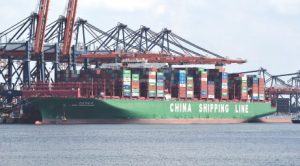 China has been preparing for the past two decades to assert its Super Power status. It had evolved a focused strategy accompanied by definite scheduled time-bound goals. It goes to the credit of the successive Chinese leadership that they have reinterpreted Communism to cater to the needs of its national goals. With its entry to the World Trade Organization (WTO), China decided to become a manufacturing hub of the world using the western capital and the state-of-the art technologies. During the past two decades with its huge trade surpluses, it simultaneously started securing trade routes stressing one belt one road (OBOR) and sea-ports.
China has been preparing for the past two decades to assert its Super Power status. It had evolved a focused strategy accompanied by definite scheduled time-bound goals. It goes to the credit of the successive Chinese leadership that they have reinterpreted Communism to cater to the needs of its national goals. With its entry to the World Trade Organization (WTO), China decided to become a manufacturing hub of the world using the western capital and the state-of-the art technologies. During the past two decades with its huge trade surpluses, it simultaneously started securing trade routes stressing one belt one road (OBOR) and sea-ports.
China has quietly been buying up the development and operational rights to a chain of ports that stretch from the southern regions of Asia to the Middle East, Africa, Europe, and even South America. The big Chinese state-owned firms began acquiring ports around the world rather quietly roughly a decade or so ago, now, under the strategic framework of what has been dubbed the 21st Century Maritime Silk Road (MSR) — the watery part of the broader Belt and Road Initiative (BRI). In the past year alone, China has invested over $20 billion into seaports on foreign terrain, doubling the amount they spent in the previous year.
The acquisition of ports is an established part of international trade and business, but their fortification and deployment of Chinese military has alarmed, though belatedly, the world powers, especially USA. In this strategic power game, India is just one of the challenges to the Chinese efforts, she has to be over-awed with the might of the People’s Liberation Army (PLA) and her neighbours need to be Chinese allies as a part of asserting the Chinese hegemony in the region. In this context, the Chinese acquisitions of the Indian Ocean ports from Myanmar, Sri Lanka, Pakistan and now the Iranian seaports, including Chabahar, should be understood.
India appears to have lost the Iranian port, Chabahar, which had recently become partial functional to connect an alternative route to the landlocked Afghanistan, which so far had dependent only upon the mercy of Pakistan. Many in India may feel that the Indian diplomacy has failed in Iran, as India could not convince the US president, Donald Trump, Iran might shift towards China. However, on the other hand, the US logic was that it would be a mistake to blame the Trump administration for forcing Iran to the Chinese camp.
The recent burning of the documents at the Chinese consulate at Houston, Texas, could be related to the activities of the deep state of China in USA. In spite of the Chinese protests, it was asked to close down its consulate within 72 hours on July 21. Earlier, the Trump administration had decided to endorse it had signed with European allies the nuclear deal with Iran ending its isolation. With the exit of US from the region, China now could deal with the region’s totalitarian regimes. It already had Pakistan to its fold.
Apart from taking the ports of Gwador from Pakistan and Chabahar from Iran, Chinese are developing a port as Jask, near the Strait of Hormuz. It would give the Chinese a strategic vantage point on the waters through which much of the world’s oil transits. The Chinese navy will soon be challenging the US Navy’s Fifth Fleet deployed in Bahrain in the Gulf. It may also be noted that US never formally protested the Chinese military base in Djibouti, Somalia, set up in 2015. It is within miles of the American base in that country. Since 2014, the Chinese navy has participated more than three times with Russian and Iranian navies in the Gulf of Oman.
It is obvious that China with huge trade surpluses is investing the resource-starved countries to serve its trade and strategic interests to build up geo-economic leverage, These new acquisitions add to China’s growing portfolio of international port holdings, which now span the world with terminals in Greece, Myanmar, Israel, Djibouti, Morocco, Spain, Italy, Belgium, Côte d’Ivoire, Egypt, and many other countries. The phenomenal economic growth of China could never have been possible without the covert and overt support of the US and its allies. During this ongoing confrontation, India is a frontline state facing the furious dragon ready to swallow entire South East Asia. In this undeclared war enveloping the world, China considers India, one of its main impediments of its assertion to become a Super Power. The observation is partially true that China appears to have outwitted India in the South-East Asia, but if we consider the fact that India alone has been resisting the multi-dimensional Chinese aggression, and even ready to confront it militarily. India’s basic approach is on sound logic and rationale. The initial successes may become liability even for China in the coming years. The protests against its policies have begun in Nigeria, and even Sri Lanka may like to walk out from the 99-year lease given to China for its port. The myth just evaporated in the high Himalayas. The GO resembles chess, but it is much more complex. It is an abstract strategy board game in which the rivals try to encircle the opponent for gaining more territory. It is being taught in China as a war game. There are 20 possible opening moves in chess, while in Go, the first player has 361 possible moves.
It has a similar mix of strategy and tactics like chess, but with an element of unpredictability it uncovers a whole new world of possibilities and creativity. It is little surprising for the Indian policy makers about the Chinese assertions in the immediate region as well as in the other parts of the world. India has already paid a huge price for learning the Chinese war games. The world is now learning it that too under Covid-19.
In this context, India’s initial refusal to join the regional comprehensive Economic Partnership (RCEP) comprising China, Japan, South Korea, Australia and New Zealand during the November 2019 negotiations could be understood. India had promised that once its issues related to farm products etc could be addressed, she too could be a part of the RCEP. However, the RCEP could not materialize due to the leak of the Corona Virus that too from the Wuhan laboratory of China during this period. Amidst this crisis, China’s decision to end the Hong Kong’s autonomy too appears to be a part of the Chinese war strategy of invoking the 360 moves of the Go.It even threatened UK to witch off its nuclear power plants under its supervision.
In the South-Asian region, China now controls almost every seaport across the Indian Ocean, whether it is in Myanmar (Burma), Sri Lanka, Pakistan and now Iran. With Iran in its orbit, China appears to have succeeded in hitting India hard not only in financial terms, but also her strategic presence in the region gets setback. The logic that India had little option, but to quit Iranian project due to the immense US pressure needs close examination. In this battle of nerves, India has been playing her key-role in the region with caution. However, with the Ladakh confrontation, India has little option but to face the reality of the power game, an avoidable conflict being forced by her neighbor.
Meanwhile, the US regulators got the port of Long Beach in California released from the Chinese clutches. It is one of the busiest ports of America. It was run by the Hong Kong-based Orient Overseas International Ltd. (OOIL), which was acquired by the China Ocean Shipping (Group) Company known as COSCO. The Trump administration pressurized the Chinese firm to divest from one of the United States’ largest commercial ports citing national security concerns. In next 50 years from now when China has a complete network of ports and trade routes that cover the globe and their hands on a powerful set of levers that give it full control of their supply chain and the geo-economic leverage to do what they please.
letters@tehelka.com












